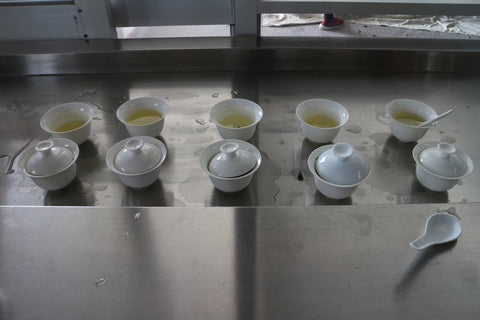Anxi and its Tieguanyin
Anxi, 22 April 2018
Anxi is the county of Tieguanyin, an oolong tea much in vogue during the last few years. Before leaving for China, I contacted three producers whom I will visit during the next three days.
In Quanzhou, a costal city an hour by car from Anxi, I meet Spencer; a friend who will accompany me for a few days as an interpreter.
Upon arriving at the town of Anxi (both the name of a town and the county) we go to a wholesale tea marketplace to taste some teas and collect samples, which we will taste over the next several days to evaluate other teas. At the market, there are shops of local merchants; but the most interesting part is the large space covered by a canopy, in which the producers who have arrived in the morning sell the tea produced in the preceding days. The prices are quite low, but the purchase would be somewhat blind; I prefer to visit the gardens and monitor the production before buying Tieguanyin.

Farmers selling the tea produced in the preceding days at the wholesale market in Anxi.
Shop owners tasting the tea before buying.

The leaves are separated from the stems by hand, transforming Mao Cha (semi-finished product) into Tieguanyin ready for to be infused.
At lunch, I meet my first contact, one of the four proprietors of a medium-sized cooperative company which owns several tea gardens near Longjuan, about an hour from the town of Anxi. To ensure the quality of their Tieguanyin, they have introduced the traceability of their products through QR code. Each package of tea contains one, with which you can look up the production date and the plantation of origin.
Up until several years ago they also had organic certification, as I can personally attest. This is, however, expensive to maintain, as it must be renewed every year; they therefore decided to limit themselves to the "green" certification. There are three different levels of quality for food products in China: the first is mandatory and restricts the maximum levels of pesticides; the second, the "green" certification, has stricter limitations; the third is organic certification, which restricts not only the levels of pesticides in the finished product, but monitors all stages of production.
We go to the countryside to visit the company's gardens, several well-tended acres of tea on the summit of a mountain, at an altitude of 700 to 800 meters. Between the rows of bushes, they grow rape flowers to attract insects, thereby limiting the damage to the tea plants.

Different views of the cooperative's tea garden. Each plot has unique characteristics relating to the type and age of the plants. Six are the nationally recognised cultivars for the production of Tieguanyin: Tieguanyin (the name of the tea is also that of one of the cultivars), Ben Shan, Mei Zhan, Huang Jin Gui, Mao Xie, and Da Ye Wulong.

One of the plots, with twenty-year-old Tieguanyin plants allowed to grow up to a metre-and-a-half tall.
In the afternoon, that evening, and the following morning, we visit some factories, taste several teas, and observe the stages of production of Tieguanyin. We are joined by a cheerful gentleman in his seventies, Mister Chen; he is our second contact. The cooperative owner seems to do everything possible to avoid leaving us along with Mr. Chen; fortunately, having contacted him weeks earlier, we have his WeChat contact info. Tomorrow we will peek behind the scenes of the cooperative and learn the role of Mr. Chen.
In the photos below: one of the cooperative members has the most modern machines, while those made of bamboo are in a second factory, run cooperatively by another member and Mr. Chen.

Tieguanyin leaves left to wither (the first stage of production after plucking).
The first meeting with Mister Chen.


Above: The leaves are placed in rotating baskets; rubbing together aids in oxidation. Leaves oxidising.
Below: details of the leaves with visibly oxidised edges. Master Chen explains how to distinguish leaves from Tieguanyin and Huang Jin Gui by touch.

Above: workers wait for the first phase of oxidation to finish, after which they fill the rotating baskets again; the bruising and oxidation are alternately repeated three or four times.
Below: group photo. Left to right: the manager in charge of processing; Spencer; myself; Master Chen; Renato, the son of one of the members (he has an Italian name because he studied in Italy for three years); Carlo, a schoolfriend of Renato.
Longjuan, 23 April 2018
Just after dawn, we visit one of the factories again, in full production. A dozen employees alternate between the different machines. The air is heavy with the scent of tea; time to taste the samples collected yesterday!

Machines for the "Sha Qing" (kill green) phase, in which the leaves are heated to stop oxidation. Leaves in baskets immediately after "Sha Qing".

After "Sha Qing" the leaves are rolled in a rotating machine.
During the last stage before toasting (optional), the leaves are dried in an oven.
Finally, we have a bit of peace and quiet to taste tea. I am accompanied by Renato and Carlo; Mr. Chen soon joins us. It is easier and more pleasant to have company for a tasting—one is aided in opening the packages, weighing the leaves, and counting the minutes for infusion. But, above all, they exchange opinions on appearance, fragrance, and taste, consolidating their impressions. Mr. Chen not only comments on the flavour, but also upon the possible errors in production; for example, Sha Qing was given too low a temperature, resulting in a grassy flavour.
We divide the tasting into two phases. First, we drink the "Qing Xiang" (fresh fragrance) Tieguanyin, and then the "Nong Xian" (robust fragrance) Tieguanyin. The first has green leaves and a light infusion—it is a less oxidised tea, with a light and floral flavour, often lightly acidic; the "Nong Xiang", on the other hand, is traditionally processed, with leaves oxidised longer, and sometimes toasted as well. The flavour is much warmer, softer, and more intense.


Tieguanyin tasting with Renato and Mister Chen.
Below: Qing Xiang (fresh fragrance) Tieguanyin on the left and Nong Xiang (robust fragrance) Tieguanyin on the right.
After the tasting, a car picks us up to go to Mr. Chen's factory. Renato and Carlo go back to town, leaving me with Mr. Chen and Spencer. And now, the most interesting chapter of the visit to Anxi begins. The following encounter with Mr. Chen, however, merits its own blog: continue reading about the Taiwanese Tieguanyin Master.
Written by Gabriele






















